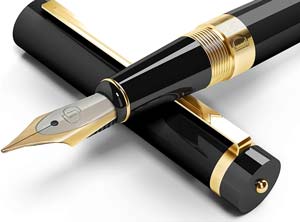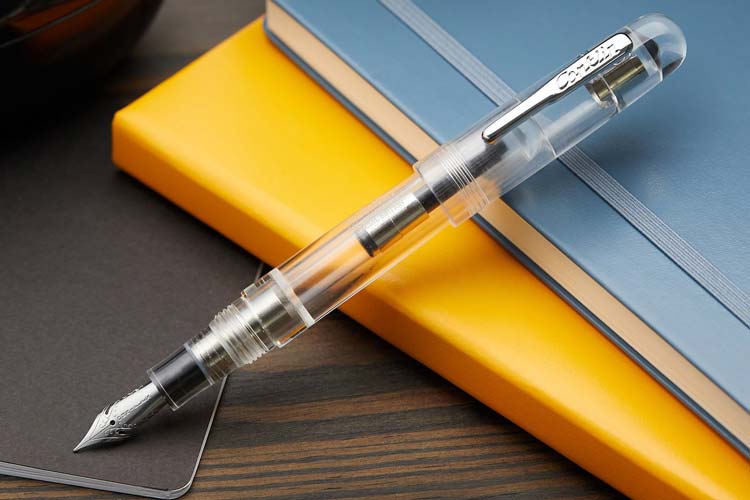Folks obsessed with fountain pens know very well about its unique benefits. It's a great way to skip that old and traditional nib dipping that could easily make a mess.
From their convenient ink reservoir to comfortable grip, compact design, and overall performance has rapidly grown a huge reputation among many enthusiasts. Students and teachers wouldn't think of starting great writing without it!
But ever wonder how everything started since the invention and what’s the history of fountain pens? Well, it’s time to take a look into that!
What is a Fountain Pen?
Like other writing utensils, it's a pen for writing things down on paper. The ink is mostly water-based which prevents any unnecessary saturation. So you can have ghost-free smooth writing without skipping or bleeding through the paper.

Body compartments of a fountain pen include a metal nib, feed, section, converter, ink reservoir, outer barrel, and cap, etc. Hence, the reservoir holds the ink that easily outperforms traditional pens needed to dip into the inkwell while writing.
Writing Mechanism of Fountain Pens?
When you hold a pen in your hand and start writing, the ink flows down to let you do that. It all starts from the reservoir and goes to the nib through the feed. And the final deposit takes place due to the gravitational force with your capillary action.
So fountain pens are great for a handful of writing needs. You can take class notes, make a planner, mark something on your calendar, use it as a calligraphy pen, or whatsoever!
Once the ink is finished, you can refill it easily. Just use the converter and get some high-quality fountain pen inks and you’re good to go! You might also use a syringe or an eyedropper as an alternative to the ink converter.
So basically, you take the ink from the bottle using some sort of suction technique. And then load it into the reservoir. But don't tilt the bottle since it's neither good practice nor going to work.
The Invention of Fountain Pen
What Qadi al-Nu’man wrote in his book was that the Egyptian Caliph Al-Mu’izz once asked for something that would give him more writing pleasure. He didn’t like the nib dipping into inkwell since it was creating more mess staining his hands as well.
So his fellows developed something that had an ink tube or reservoir to hold the ink inside. He could write with it and even hold it upside down without worrying about ink spilling. In other words, it was leak-proof to some extent.
Another proof that historians took note of is the journals of the artist Leonardo da Vinci. His journals contained writings that prove the use of pens with an ink reservoir. The writings were very consistent without much of a random contrast of ink.
Historians noticed the absence of fading patterns typically found when writing with a re-dipping traditional pen without an ink reservoir. Following that, another artist Amerigo Bombara developed a few working pen models in 2011.
These models are kept in the museum for display and dedicated to Leonardo.
Evolution of Fountain Pens over Time
In the 17th century, fountain pens were seen available in European countries. A German inventor (Daniel Schwenter) described it in a magazine in 1636. He wrote about a pen that had two quills, one holding the ink and placed inside another quill.
The ink was sealed using cork to make it leak-proof. And there was a small hole towards the writing nib that allows the ink to deposit for writing.
Later on, metal pens with ink reservoirs were referred by Samuel Pepys in 1663. These types of pens were commonly known as fountain pens in the 18th century.
Following all those previous events, standard fountain pens were developed in the 19th century. It had a less expensive steel nib which expanded the mass production.
In 1827, Romanian inventor Petrache Poenaru was recognized by the French government for his invention of fountain pens. It was made of an outer barrel with a large swan quill.
Again, Azel Storrs Lyman received a patent for a pen with an ink supplying reservoir inside, in 1848. However, several other patents were existent at that time. But they still needed a lot of work to become popular in the market.
Afterward, in 1850, an upgraded model was released with more convenient features.
Alonzo T and Duncan Mac In 1870, created the stylographic pen with an ink tube. They put a wire as a valve for the tube. The ink refilling had to be taken place using eyedroppers. Then the first self-filling fountain pens come to be known in the 20th century.
Improvements Kept Rolling
All the early fountain pen models had some issues either one or more. One of the major issues that manufacturers often tried to solve was the ink reserving mechanism. It was quite hard at that time to create something totally leakproof.
All of those patents kept rolling the dice of improvements days after day. They tried with retractable nib, screw cap, inner cap, cork sealing, and so on.
Inventors also worked to improve the ink refilling mechanism. They used levers, eyedroppers, pistons that pretty much extended the longevity of the pen.
Frequently Asked Questions
#1. When was the fountain pen invented?
It's been a long history and we’ve covered a lot about it in the above segments. However, it was on May 25, 1827, when Petrache Poenaru a Romanian inventor was awarded for his first patent of a fountain pen. It holds an ink reservoir and gives the idea of a great alternative to all those old traditional pens.
#2. Why is it called a fountain pen?
Because of the consistent and continuous ink supply from the reservoir, it's called a fountain pen. In other summation, it's the fountain of ink that flows from a wellspring.
#3. What is so special about fountain pens?
There are so many specialties in fountain pens. You can use them for a variety of hand writings like calligraphy arts, note-taking, planner making so on and so forth. Besides, their appealing outlook is quite attractive that easily gives you a better writing experience. And the ink refilling mechanism has elevated the usability way further.
Final Word
So that’s pretty much it about fountain pens being one of the most appealing writing instruments nowadays. We hope some of you in the audience now feel a little more knowledgeable about what, how, and where the history of fountain pens begins!
If you feel like you’ve really learned something amazing, please let it go viral! And don’t forget to let us know about anything you’ve to say regarding this article.
